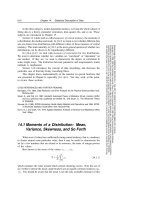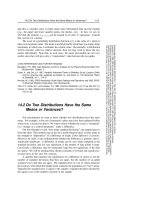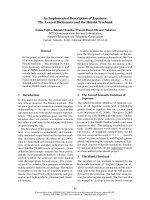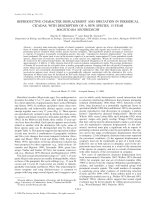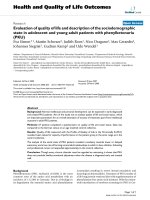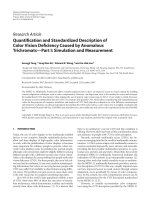Description of several new species of Cynips and new species of Diastrophus, Bassett 1864
Bạn đang xem bản rút gọn của tài liệu. Xem và tải ngay bản đầy đủ của tài liệu tại đây (7.29 MB, 13 trang )
1864.]
679
Descriptions of several now species of OYlUPS, and a new speoies of
DIASTROPHUS.
BY H. F. BASSETT.
QUERCUS RUBRA. .A cluster offort!f or fifty elonga.te-ovate gall8 on
a branch of a !f0u/ng red oak tree. Tht.y are from three-foo.rths of an
inch f.o an inch in. length, and a half an inch, in diameter in the middle,
tapering to a po"nt af tile ends; covered with a Jwrt, velvety pubescence, and when dr!f, ridged like a melon; tke imide, cork-like substance adhering closely to the larval cell, and divided lengthtoile inf.o
ma1t!! parts like the dissepimetlf8 of the seed-ve3Sels of various kinds of
plants; f'Mnothalaf'Mus-the cell one-tenth of an inch long.
a
I
c. q. form~sa
n. sp.
Head black. Head and {ace finely and evenly rugose. Ankn1U2 1~
j&inted, yellowish-red, the terminal joints darker. The suture between the 14th
and 15th as distinct as the preceding ones; (ace with a short pubescence, the
hairs converging towards the mouth; mandibles black, palpi yeJIowish-red.
TMraz black; a few short hairs on the collare; muotAoraz: parapsidal grooves
distinctly marked, median line broa.d where it begins on the scutellum, but
gradually decreases and disappears just before reaching the collare; between
this and the para.psidal grooves two shc.rt lines beginning on the collar and extending half way to the scutellum. The thorax and pleune are beautifully
ripple.marked with fine short traMVerse linea. This style of marking is distinct
from that of any of the species in my collection-thirt.y or more. The same
style, only coarser, is soon in sOIQe Chalcidians. SdJ.tellum sma.ll, finely rugose,
the small fov~ are smooth and shining. Legs bright brownish-red, except the
upper part of the femur, which is nearly black, and the black cOxre. Abdomen
bright reddish-brow,p. with an extremely ,minute microscopic punetation;
sheath of the ovipositor a ~ark brownish-red. Wings hyaline, also the veins,
except the first and second transverse and the subcostal, which are a very pale
yellow; areolet large, equiangular, bounded on the inner side by entirely colorless veins, radial area open. Length ~12. "b unknown.
9.
The llies have not yet left the gall (Nov. 25) though they have been
in' the imago state for several weeks, a.nd crawled about actively when
the galls were opened. They may be imprisoned by tlie hard dry gal),
but I am inclined to think, that, like some other species, they remain
in the galls in the perfect state through the winter and come out early
in the spring.
,~.
_ /
'" .
'VoW
-'-.
, ••
"-"-'~'1'~
.• -•.. "
.
l'
_n_.,
:-~
680
[DECEMBER
The galls of this speoies are very rare. I have found only two clusters, and one of these was much eaten by some tepidopterous larva,
and the larvm of the true gall Hy were destroyed. Only a part of the
galls in the other cluster were developed as described above; the smallest were not larger than grains of barley, but contained larvre, and have
produced true gall Hies. Their diminutive size was owing, apparently,
to their being closely crowded.
This and the species next described, a. g. veluricosa n. sp., are readily distinguished from any other American species yet described, by
the female, (male as yet unknown,) having fifteen tii~tinct antm"al
joints. Dr. Fitch (N. Y. Rep. Vol. 2. No. 309) speaks of having, in
his collection, a female gall By with fifteen jointed antennte, but he
does not describe it, nor the gall from whioh it came.
Westwood (Syn. Gen. Br. Insects) does nQt characterize any genus
of the family Cynipidre as having more than the ~ 14, and the ~ 15
antennal joints-but the ~ of my O. q. singularis* (Proc. Ent. Soc.
Phila. Vol. 2nd. p. 326) has 16-jointed antennre, and
q. Rcitula-a
new species described in this paper-also bas tbe same number. The
females of botb these species have only 13 joints, the terminal one long
and connately divided in the middle.
a. q.formosa and the species next described are evidently closely
related, for besides the 15-jointed antennte of the ~ there are other
points of resemblance; and the remarkable di1ference in the colors of'
the two species, the ripple-marked thorax of O. g.formosa, and the
widely different galls from different species of oak, are the most marked
specific characters. The shape of the abdomen of both species is peculiar; differe~t in form, and, I think, in structure, from any other species I am acquainted with, but I have not yet sufficiently studied the
structure to describe it well, and have simply, in my description, noticed the vertical diameter as equalling or exceeding the length.
a.
.
• Mr. Walsh assures me that my C. q. singularis is the same as C. q. nubili- .
penni!J Rarris. He is undoubtedly correct, and my name stands, of course; as
a. Synonym. Dr. Harris' very brief descriptions were definite enough, perhaps.
when the number ~f species VIas, as when he wrote, very small, but hardly complete enO\lgh for the genus to-day. The num~er of species described and
properly belongmg to, or provisionally placed in, the genus Oynips, exceeds fifty,
and many more will probably be found.
•
0'
,
:
...
~~
...... ".
681
1864.]
QUERCUS ILICIFOLIA.
Galls grOOJing in cl1£8ters.from three or foor
to a dozen to.'letker, on the limbs and occQRitmall!l on the trunks ofyoung
shrub QaJa. TM!! fire cone-shaped, truncate at tke base, tke apex often
prolonged
a sl.ender, recurve~ point. .They are from four to jiveeighths oj an inch [mag, and from one.jourth to three-eightks in diameter at the base. When green, oftm of a deep red color; 'When dry,
brown nr black j lJer!! hard, enclosing a near{y free larval cell like that
nJ C. q. globulus, Pikh.
in
c. q. veutricosa n. sp.
s.> • Head and thorax a bright cinnaJllon color, head finely punctate, face pubescent, dark brown around the moutb, tips of the mandibles black, palpi pale
brown. .Antenna: long, 15-jointed, third joint longeat, others gradually decreasing in length to the 15th, which is as long as the two preceding ones, and shows
plainly a connate suture. Thore= tinely arid evenly punctate; parapsidal
grooves not deep; the line dividing the mesothorax lengthwise reaches from the
collare to the scutellum; each side of this is a line reaching half way from the
collare to the scutellum, floDd marked with an indentation at the posterior end;
also a deep linear depression on each side over the base of the wings; pleura
microscopically /punctate; mesothorax bounded on the sidea and where it joins
the scutellum by a dark reddish-brown line. Scutellum very nnely SCUlptured,'
a dark and narrow ridge dividing it half the length. Feet yellow, tips of the
tarsi black. Wing8 hyaline; the subcostal, anal,. first and second transverse
veins large, dark reddish-brown; the ~rst two ra.ther paler towards the base;
areolet distinct; radial area open, the vein formi~g its base considerably enlarged. Abdomen darker brown than the thorax; segments short, second longeat; vertical diameter, i. e. the distance from the back of the abdomen to the
ventral edge, equals or slightly exceeds the length; terminal segments show a
fine punctation. Length .14. Male unknown.
My galls were collected in June. The Hies were found to be fully
developed in October. They were cut oat, else they would probably
h~ve remained in the ~Js until 8pri~g.
QUERCUS ILICIFOLIA. Elongated, fusiform ga1l8 grCluiing on the
upper side of the leaves of Q. ilicifolia, and standing erect, or nearltl
so-sometimc8 entire{y preventing the development of the leaf, and a.pparently growing out of the petiole. '1' he centralllucleus C(jf&taining the
larlJt£ is kept in place b!! radiating 'Wood!! fibru as in O. g. inanis o. 8.
The largest ga.lls are two t"nches in length and seven-eight1l.8 oj an inch
in diameter; average size about one and three.jotirtks t~nchu long, and
three.jourths in diameter. .Apex rather wnger and more slender than·
the bcual portion, and often comi4.erably curved.
•
:"
":.~':
• ....
,'1"
682
[DECEMBER
These galls are of the same dark greon as the leaves. Many are
found very much smaller than those desoribed above, but they produce
parasitic Hies. Baron Osten Sacken writes me that he met with numbers of these galls in Penns,lvania. several years ago. They are rather
rare here (Conn.)
Q. q. UicifoUlB n. sp.
2 Black, vertex of the head, a.nd the entire thorax black, and deeply and
irregularly--sculptured; face rugose a.nd pubescent; hairs converging toward
the mouth; p&lpi shining reddish brown. AnUmue l3-jointed, the 18th long.
and with a f&lse suture apparent on the inner side; first and second joints very
short, shining black; the remaining ones pubescent, and dull black. 'l'Aoraz
with a coarse pubescence. The parapsid&1 groove obliterated by the coarse,
somewhat linearly arranged sculpturing. FOvelB large but sculptured like the
rest of the scutellum. JiUt: COXlB, and the upper part of the femur of the two
anterior pairs black-other parts reddish-bro~n; posterior pair black, reddish
at the joints. Abdomtn black shining, the ventral edge clear brownish red.
The segments, except the first a.nd second, with a very fine microscopic puno.
tation, most apparent on the third segment. Wing8 slightly dusky; veins brown.
ish black, heavy; aieolet very small, vein at the base of the open radial area
covered by a large brownish black cloud, which covers part of ·the areolet but
does not reach the anterior margin of the wing. A very Ught brown cloud in
the basal cell of some specimens. Length .1'1.
'b .-AntennlB 16-jointed, feet darker than those of the female; posterior pair,
including the tarsi, almost entirely black. Otherwise like the female except the
usual sexual differences. Length .14.
Ten
..
<.?
and four 'b specimens.
QUERCUS ALBA.
Flat, green., succulent galls, often 0/ a veru irregu.
lar outline, and from one-fourth to more than an inch -in dt'ameter, the
·uertical diameter from one-fourth to tlu'ee-eighths ofan inch, growing Oft
the !eCl.ves of the white oak, and producing, according to the size, from
two or three, to more than (t doze-n gall-flies..
The ilies ·escape from the galls i~ June, through the upper or under
surface. The water that enters the cavities the Hies have left. causes
the galls 8000 to decay aDd drop off, but a few change to a dry pithlike substance, and remain on the tree through the summer. These
might be taken for a. different species, as they generally contain larvm,
but having reared a few Spalllngia (7) from such galls, I infer they are
aU parasitic.
This species is closely related to O. q. irregularis O. S. but grows on
a different speoies of oak, and Baron Osten Sacken to whom I sent
..
/
.
. ::'-.
1864.]
683
specimens, tbinks it may be specifically distinct from tbat species,
which I have 'not yet seen. The imperfect condition of his only specimen of O. q. irregvlar1's renders a satisfactQry comparison impossible~
and actin~ upon bis suggestion, I describe it as
c. q. ~a1i8
n. ap.
.
transverse, black, nearly smooth, but under a powerful maguifiet:
presents a fine netted appearance; face smooth with a very few short white
hairs; mouth brown, tips of the mandibles black, .An~ long, with 13 jointe,
first and second short, third very long and enlarged at the upper end. These,
except the slightly enlarged portion of the third, are a pale yellowish white,
the remaining joints a light opaque brown. TAor= black, smooth and sbining; without any grooves or striee whatever on tbe mesothorax. 8cutellvm
smooth. separated from the mesotborax by a broad sballow groove; foveee wanting; marked posteriorly by two dup tra~segrotnJU, 'causing three transverse
ridges above th~ insertion of the abdominal peduncle. Feet white witb a tinge
of yellow, like the basal joints of the antennm. .Abdomen black, smooth; in dry
specimens shrunken and wrinkled. Wings large with a faint duskineas and a
dusky cloud resting on the first transverse vein; veins dull brown; areolet present; radial area open, long and very narrow. Length (dry) .09.
~ .-Ht4(/. black; antennre 15-jointed i three basal joints paler than of tho 2 ;
others a semitranslucent brown. Third joint' very long, remaining ones short,
and of eqnai length. Third joint curved rather than incised. TAoraz, the
feet a~d the first and part of the second segment of the abdomen very light
yellowish brown. The central part of the mesothorax dark shining brown;
terminal segments of abdomen dark brown i in some specimens nearly black~
Length .10,slightly longer than the ~.
2 Head
Severd) hundred
1) 1)
and 2 2.
Woody, tUber-like gaU~, growing on the green
oj Q. tinctoria, sometimes simp'l!J an enlargement oj tke limb,
tit otherR entirel§ checkl;l[J its growtl" tI'Ild covered witA lelltJeB. They
QUKRCU8 TINflTORIA..
branch~8
are from thrce-!ourths to an inch and a half t'" length, and rather more
than hnlf an incJ" in diameter at the bau, tapering to a r.one-like point.
C. q. scitula, n. sp.
~'. ~. Black. Ht4d, vertex black, subrugose; sides of the head and the f'aee in
sOme' specimens a very dark brown, with a. sbade of red, but most are a dull
brownish black; face pubescent. .Antenna: 13-jointed, the 13th long and in the
middle connatel,. divided; the basal joints yeIJowish~brown,tbe terminal dark
brown, tbe transition gradual. TAor
,a Bbo~ deep groove over the base of the wings. 8cuWlum regularly and finely
sculptured; basal pits obsolete. Feet shining yellowish-brown. Middle-of the
!
'·1'....
,"'·;
.
~~
f .
684
(lJECEMBER
femur and tibia darker than the joints, tarsal tips black. W"mg" hyaline, 1st
transverse and radial veins dark brown, others pale but distinct; areolet oC medium size and at the base of the open radial area. Length .09.
The $ closely resembles the 9 in color and markings. The aWomen is very
long, and the antennre a rich amber color, with a few of the terminal joints of
a light brown. In all the specimens I have examined (16) the ft~ of an.
tmn4ljoint6 is 8i:ctun. Length .08•.
Numerous 9 9 and 25 $ $.
Dr. Fitch has given a very correct figure and description of the gall
of his O. q. batatlUJ, which, it will be seen, closely resembles that of the
above species. Indeed there is little or no apparent difference in the
galls more than pertains to the different species of oak 00 which they
grow, bot the ft.ies are very distinct. As Dr. Fitch describes the ft.y so
very brieft.y that it ina.y easily be confounded with' O. q. scituJa, I give
a more full description below:
Quercus alba.
O. q. batctus Fitch.
(N. Y. Reports, Vol. 2nd, No. 311.)
Black, shining, entire head black, vertex smooth; face, covered with a
fine thin pubescence; color of the pal pi, clear vitreous brown. Antmna: 13.
jointed, first three joints pale yellow, others a pale semi·translucent brown.
Thoraz black, shining, but under a powerful magnifier shows a net-work of fine
lines; parapsidal grooves.and strire obsolete. Scutellum smooth, polished; a
few scattered hairs on the posterior portion; basal pits wanting; separated
from the mesothorax by a deep shining groove. Abdomen black and polished
but in all iny dry specimens contracted and wrinkled. Feet, COXllB clear yel.
lowish brown, feIDur, in the middle dark brown or black, as is also the tibia of
the posterior pair; remaining portions, except the tips of the tarsi which are
black, are of the same color as the COXllB. Wing8 hyaline, all the" veins dark
brown and of nearly equal size. The cubitus large and heavy its whole length i
areolet large; radial area open. Length .09.
$ .-The antennee of the male is 14-jointed. Feet dull pale yellow. Abdomen
petiolate by the elongation of the first segment. Length .08.
~
Numerolis specimens $ and 9.*
• I am satisfied that there are annually two generations" of 0. 'g. batatus. The
first appears early in May, from galls of the preceding year's growth,-the last
late in June, CrolD green galls, I have often (ound perfect insects in the galls
in winter, and have r('\ared Oies from them, apparently of the same species
reared from the summer galls. Inquilinae in great numbers are produced from
the winter galls and few true gal18ies, while the reverse is true of the summer
Corm. As many of the I\ummer g~lls remain green after the Oies have left them,
and as the tree's annual growth is nearly or quite complete the first of July, it•.
II
~
.....-"",.
1864.]
685
QUERCUS ILIOIP'OLIA.
Olub-shaped, woodg galls, growing on the
ent:U of tAe small limbs. .Apex blunt and generally tUNlecl to one Me,
covered in summer with a few leaves and conta,·m·ng one, and occasionally tfDO or three larvt& It is strikingl!l like that of
q. tuber of
Fitch, but produces a fly whUih though closelJl related, is evidently a
different speciel.
o.
c. q. simi1is
n. sp.
Head a.nd thore.x a. bright brownish red; vertex of the hea.d. finely sculptured; the rather prominent ocelli a.re blaCk only at the a.pex, face pubescent;
hairs short, converging towards the mouth. Antenna: IS-jointed, the 13th nearly
as long as the two preceding ones and in some individuals there is an obscurely
marked conna.te suture. Phoraz coarsely puncta.te, sparsely ha.iry, a shade
darker than the hea.d, three faint longitudinal lines rea.eh from the eollare to
the scutellum, and two other lines; one on each side a.nd very close to the median line, start from the oollare and extend ha.lf-way to the scutellum; obscure
line over the base of the wing
&u.uUum sculptured, basal pits small, deep ,
and smooth. The centra.l portion of thE'! pleura-in many spe.:ies smooth and
polished-is in this covered with very fine longitudinal stril9. The legs of a
uniform brownish red, except the tips of the ta.rsi which are black. Wings, a
sUbopaque white, the subcosta.l, anal, 1st and 2nd transverse very pale yellow,
others colorless and the 'Dein tJjhicA bounds the. potlterWr silk of the radial area in
other 8pcciu is, in this obsolete, as is, aho, tAe cubitus and areolet. .Abdomen, red,
except the dorsal portion of the middle segments which is nearly black j terminal segments withdrawn into the others in dry specimens, and the sheath of
the ovipositor turned a.bruptly upward but does not. extend above the back of
the abdomen as in the Inquilinm. Length .12.
1>. Black head and thorax. AntemuB IS-jointed, 1st and 2nd joints nearly
bla.ck, others red. Legs, posterior pairs dark reddish-brown, the posterior pair
dark brown, nearly black-all iighter a.t the joints. Abdomen black and shining, 2nd segment long. It is much s.maller than the fema.le. Length .08.
2.
Q•
16 2 , 4 1; specimens.
c. q. tuber
Fitch. (N. Y. Rep. Vol. 2nd, No. 309.)
2.-Head black, sides, however, in a strong light have a. tinge of red; face
black, pubescent, hairs converging towards the mouth Antenncz yellowishbrown, IS-jointed. Thorru:, a reddish tiDge on the shoulder of the collar; other
parts black, ra.ther densely pubescent: Thr.ee locgitudina.llines somewhat obscured by the pubescence; two short lines extend ha.lf way from the collare to
the scutellum and there is a short faint line over the base of the wings; scutel·
lum rough, hairy; fovm medium size; smooth spot on the pleura polished, shining, but Dot perfectly smooth. Leg, brown, ,tips of the tarsi black. .Abdom.en
seems probable the June flies oviposit in the galls from which they were produced.-Jan. 28, 186b.
.· •• 0.
686
,r· ... •..
[DECEMBER
black shining, second segment longest, separated from the third by a connate
lIuture, third with microscopic punctation. Sheath of the ovipositor not turned
up nearly so much as in (J. q. 8imili3, to which speci,es it is closely related.
hyaline, sub-costal, 6rst and second transverse veins pale brown, othere
colorless; lower part of the cubitus obsolete; areolet present; radial area open.
Length .12.
•
Wing.
Nine specimens.
I ba.ve a single male gall ily reared from the same ~l1s, but it differs
'so muoh from the female that 1 am inolined to think it belongs to a
different species. The thorax is quite smooth and shining, with a few
short, scattering hairs, and only two longitudinal lines that closely converge at the scutellum. The venation of the wings is like that of the
female described above, and is unquestionably'that of a true gall.ily.
Xhe antennre light dusky brown, 15-jointed; legs dark shining brown.
nearly black, paler at the joints.
Though the galls are very much alike, the venation of the wingH,
the pleul're, and several other points of difference mark it as a distinct
species from O. q. similis. Dr. Fitch has figured the gall of his O. q.
tuber which be found " quite common particularly upon the soft, and
tender limbs of young (white oak) trees" (N. Y. Rep., Vol. 2d, No.
309). He describes (1. c. No. 310) the galls of a.. q. ctrbos as "swellinKS
similar to that above described, growing on the tips of the limbs of'
aged and large white oak trees."
My galls, which are probably identical with his O. q. tuber, were
gathered from low, shrubby white oak bashes, though I have often
see~ .precisely similar ones on large trees. Dr. Fitch's descriptions of
the ilies from O. q. tuber or O. q. arboB will apply, 60 far as they go, to
eith~r the gall lies, or to the guest mes as the inquilinre are termed by
Mr. Walsh. For the reasons that follow, I am led to think that the
species he described under the above names are both inquilinioUB
species.
lat. My gallS were gathered about the ~Oth of June, and were then
green and soft like the wood of the young shoots on which they grew.
The insects were then in the pupa state, and the imago came out early
in July. The gall froiD which Dr. Fitch's O. q. arb08 was reared was
fou~d in March, and were of the preceding year's growth, as were also
those of q. tuber, if we may judge from his description of the color
c.
·.' '."'.-:-
~
..•. : ..
:"'~""
.......
.. :
. :- -.... ~..~
~
.. ........--::.;-'.
~.~
687
1864.]
of the gall, which w~l1 only apply to the galls long after the true gallflieR have left. them.
2nd. My galls gathered from young white oaks, and which ansWer
Perfectly to hi$ figure and description of O. q. tUber, produced females
with HI-jointed aotenom, while his have but 12 aoteonal joints.
3rd. I have gathered several hundreds of these galls in the .autumn,
-winter and early spring within the last two or three years, but have
never reared from them one' true gall-fly, though they have produced
large numbers of male and female gueat-flies-the male answering perfectly to Dr. Fitch's description of O. q. arb08. The female he had not
seen.
4th. The galls I collected in June have not yet produced any guestilies, but cutting open several to-day I found in one a large living
larva-the others were empty or contained dead gall-Hies that had not
been able to eat their way out of the dried gall.
From the above facts I am forced to believe that the galls O. q. tuber
and arb08 Fitch are both produced by the same fly, and that it is the
same species that I have described above and for which I retain Dr.
FitCh's name, '0. q~ tuber'. Dr. Fitch has, no doubt, described two distinct flies, for Mr. Walah, who has devoted much attention to the
guest-flies of the oak galls, finds that not only do some s~cies live in
several difFerent species of galls, but that the same kind of gall may
produce more than one species of guest-fly. (Proc. Em. Soc. Ph:il(l,d~
Vol. 2d, p. 465.}
Mr. Walsh, in the article referred to, mentions .other of Dr. Fitch's
species which he is satisfied are inquilinm, and not the producers of the _
galls from which they were reared. (See pp. 464-5, 484 and 494.)
His remark that" O. q. tuber Fitch is in all probability a guest-fly,"
escaped my notice till this mQment.
tn
QUBROU8 MONTANA. Hard, round gaJls, .25 of an incA
d·ia·fMter with a finely papillose mrface and a 'solid radiated cdlular
ture; growing sometimes on. the upper, but as often on the under 8ide
of the leaf j attacked to the larger veim by avery'alwrt pedicel.
.tMu-- .
These ga.lls are rarely met with, and I have seldom found more than
one on a leaf. In a single instance there were three on tlie same leaf,
two on the under side and one on the upper. My speoimens weM found
in October and contained perfeot insects. Through the gall of several,
.~.
.,.
688
....".,
[DECEMBER
gathered October 20th, the insect had eaten a passage but tbey still
remain in the galls. * Each contains a single, subapterous, female gallfly, closely related to O. g.forticornil Walsh, and C. g. pezO'mQ<,lwidu
Osten Sacken. Dr. Fitch's figure and des-cription of the gall of O. q~
pisum, (N. Y. Rep. Vol. 2, No. 319,) answers well for this gall, but his
were from a dift'erent species of oak, and this gall-fly is very distinct
from that he describes. Baron Osten Sacken informs me that these
8ubapterous females have winged males and belong to the genus Andricus.
I let this species stand with the related species named above and call it
O. q. hirta n. sp.
Head black, vertex slightly rugose, densely hairy as is also the entire dorsal
portion of the thorax; {ace pubescent, hairs converging towards the mouth j
paJpi shining brown, tips black. Antenn« long, slender, black, 14-jointed.
2'Aonu: black, very small, densely covered with a coarse, yellowish-white pubescence. No stria'! visible on the mesothorax. They are concealed by the
pubescence if they exist. Feet a dull brownish black, but in a strong light
appear of a very dark reddish brown, posterior pair lightest and all somewhat
paler at the joints. 'I'M tJJi.ngs are mere yellowish white scales. Abdomen
large, black and shining, a short, close pubescence.on each side of the 2nd segment and this and the remaining segments, except the first, bounded across
the back and sides on the posterior edge by a belt of long, silvery white hairs.
These belts are divided on the dorsal ridge by a shining glabrous line like the
anterior portion of the segment. These belts are plainly visible without the
aid of a magnifier. Length .14-
Six 2 specimens.
Hew speoiol of galls, the ties of which aro, as yet, unkuown to me.
Gall a cone-likt bOff/}, developed from the
uxillaryleaf-buds, and covered when green and iiften wilen dry toith fA
Hy unknown.
These singular and very pretty galls are developed after the summer
growth of the tree is completed,. and the axillary buds are fQrmed. The
QUEROUS CHINQUAPIN.
• November 29. A single Jly was found in the' box yesterday. It is quite active, and does Dot dUrer from those cut from the galls, showing those to bave
been mature.
\
.
,"'.. --,
689
t¢ing of the insect caU'Je8 the buds that would otherwise remain nndeveloped till·the following year, to devel~p in the autumn in the abnormal manner described above.
\
The rudimentary leaves are green, ligulate, and the more perfectly
developed galls resemble, more than anything else I can think of, the
1l0wers of the common Art.emesia of the ftower ~rden. They are not
common, but 1 have several times met with them, and the clump of oak
bushes from which my specimens were gathered was covered with them.
'fhe larvre are now fully wown. On·· the same bushes I found a gall
like O. g. globtilus Fitch,-and several dry, brown galls on the petioles
of the leaves, apparently thoSe of O. q. petiolicolQ,.
Q. RUBRA. Olusters of ReecUike bodies, often thirty or fort.!J together growing on the mt"dvein on the under side of the leaves oj Q. rubra.
The larger cells a2·e about the size of a grain o/tohea.t. I'M!! are
smooth, greenisk-white, the apex enlarged, and wovld remind (~botan-ut
of the se8ttile stigma 0/ some Jlowers.-C. Q. DECIDUA, n. sp. Gall fly
unknown.
.
My specimens were collected about the first of October, and were
then fully grown. Some had fallen to the ground, but on cutting open
. a large number I could not detect any larvre. The leaf stems and twigs
were placed in water to keep them green, but the galls soon dried and
many fell off. A few fell into the water, and these not only kept green,
but on opening them a few days since, half-grown larvre were found.
From this I infer that the growth of this species is dependent upon the
galls being covered in the earth.
Gen. ·DIASTBOPJmS.
DIASTROPRUS POTENTILLlE, n. sp. Galls on Potentilla Canadensis.
, They are from .3 to .5 of an inch in diameter, and rather longer than
thick, growing in the axils of the leaves; of a soft spongy consistence
when dry, and each contains a single cell in shape and size like the nucleus of a. q. gwbulus, though not, like that, free from the substance
. in which it is enolosed. They are rather rare here (Conn.), but I sa~
large numbers of them in the northern part of Berkshire Co., Mass.,
last summer. The fty came out May 20th from galls of the previous
year's growth. l~ is much like D. nelndoBU8 O. S., but Baron Osten
Sacken has compared it with this species, and pronounces it distinct. .
<.';' , .
690
[DECEMBER
.J:((I/e.-Head. black; vertex nearly smooth, the face black, finely aciculate. a
ridge or carina from the vertex to the mouth, organs of the mouth with faintest
possible tinge of reddish-brown. Antemace: 1st, 2nd and Srd joints black. the
rema.ining ones dark cinnamon. 3rdjoint not deeply incised, 14-jointed. 'I'Mrcu: black; collare hairy; meaothor&% shining; two deep linea from collare Connrging towards the scutellum'; space enclosed nearly smooth and hairless,
'with very taint longit.udinal grooves. Bcutellum pculptured, the basal pils
large and deep. Lateral view 9£ the scutellum shows as a cone, the axis or
which is' at an angle of 4.5 deg. from the axis of the body. Legs dark brown or
black,coxte black; lemur and tibia yellowish brown, on the upper side darker:
tips of tarsi black or nearly so; plenra very finely acioulate. Alx!omea brieOy
petiolate, shining black, 2nd and 3rd segments conn~te jointed. Wing.. pale
dusky; veins heavy, nODe of them reaching the margin; vein forming the base
of radial area with heavy brown blotch. 1st transverse reddish-brown; areolet
small distinct; radial area open. Cubitus disappearing before reaching the first
transverse. Length (dry specimen) .11.
Fem4k.-Antennre 13-jointed. legs a shade darker than the male, otherwise
as the male, though as usuallar~er•. 13 long. The ocelli form nearly a straight
line on the head. Abdomen in male and female perfectly smooth and shinin~.
In Mr. Ct;.esson's Catalogue of described N. Am. Hymenoptera, Di.
plosis potentillre, Harris, occurs, taken from Dr. Harris' Catalogue of los.
Mass. 2nd ed. I have not seen Dr. Harris' catalogue. Should my
insect prove identical with hill, r shall have only removed it to Diastrophus, the geD~ to which, without doubt, it prop'erly belongs..
The following remarks and description were communicated to me by
BaroD R. Osten SackeD, for publication io this paper:
., In my paper entitled (Addition8 and Cbrrtctions,' etc., (Proc. Entom. &c.'1862)
described a gall under the name of C. g. Stro6il4M (1. o. p. 254), the producer
of which was at that time unknown to me. Many months afterwards, I obtained the fiy, by cutting the dry galls open. If'belongs to the genus GYnipa
in the restricted sense (agambUB according to Hartig), and I let its description.
follow:
Cynipa quei'01l8 strobilaDa o. Sacken.
~. Antennre 14-jointed; body dark brown, with'aclose,appressed pubescence
on the thorax and along the hind margins of the abdominal segments; fee~
. bro~n; anterior knees and tarsi reddish; wings hyaline; length from 0.1'1-0.22.
Head black, finely punctured and pubescent; palpi reddish; antennte rather
IIhtut for the size or the insect, U-jointed; third joint about &Slong as the two
first. taken. together; fourth, fifth and sixth gradually decreasing in length, the
seven penultimate jointS being nearly as long as broad; the last segment is
somewhat longer than the preceding, although not equal in length to the two
penultimate joints taken together; it shows no indication of a sub-divisiolL.
2"Aorczz densely clothed above with a. yellowish, appressed pubescence, which
~
1864.]
does not prevent, however, from distinguishing the sculpture; the latter consists ()f a moderately dense punctation and several rather shallow grooves,. two
of which, running from the collare backwards, end about the middle oC the
thorax by a slight, smooth and Oat expaDSion. PlellJ'm. black, punctured, 8%cept a smooth, shiniog spot in the middle; their lower part is pubesc~nt. &.
t.ellum punctured above, rogose behind and finely pubescent; Q:1e pi~ at ita
base are of moderate size. .A6domm pitch-black, in some specimens 8Jig~tly
reddish belo~ and along the hind ma~gin of the segments; its whoie 8urface,
except the base of the segments and a narrow, 8mooth line along the back, is·
clothed with a whitish,appreseed pubescence; under this pubescence a moderately dense p~nctation is perceptible; the second (largest) segment or thO a~
domen ha.rdly reaches its middle. The Ceet are da.rk brown, pubescent; the
base or the femora, the knees and the tarsi of the Coremost pair are reddish; in
some specimens a reddish tinge appears at the base of the Cemora' and on the
knees of the two posterior pairs. Wing, hyaline; the second transverse vein
forms a knee which bears a distinct stump or a vein in the middle.
Seven 9 specimens."
,y ATERUURY, CONN .. Dee. 1864.

